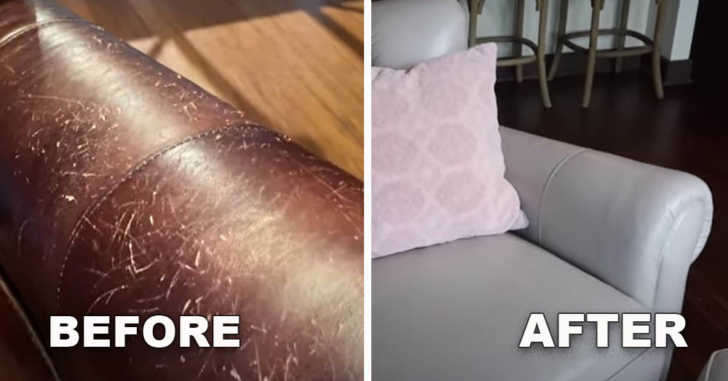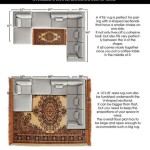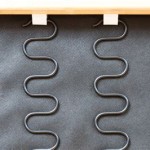How To Fix Scratches On A Leather Couch
Leather couches, with their luxurious feel and timeless appeal, are a popular choice for living rooms. However, leather is susceptible to scratches, whether from pets, children, or accidental encounters with sharp objects. Knowing how to effectively repair these blemishes is crucial for maintaining the couch's aesthetic appeal and extending its lifespan. This article outlines detailed steps and techniques for addressing scratches on leather couches, ranging from minor surface imperfections to more significant damage.
Identifying the Scratch Type and Leather
Before attempting any repair, it is essential to accurately identify the type of scratch and the kind of leather. Scratches can range from minor surface abrasions to deep gouges that penetrate the leather's surface. Similarly, leather types vary considerably, each requiring a specific approach. Common types of leather used in couches include aniline (dyed through, with visible natural grain), semi-aniline (similar to aniline but with a protective topcoat), and pigmented (a durable coated leather). Identifying the leather type helps ensure the repair process is compatible and avoids further damage.
A simple test involves applying a drop of water to an inconspicuous area. If the water absorbs quickly and darkens the leather, it is likely aniline leather. If the water beads up or is slowly absorbed, it is likely semi-aniline or pigmented leather. Understanding the leather type dictates which products and techniques are most appropriate for the repair.
The severity of the scratch also influences the repair method. Light surface scratches typically only affect the finish or top layer of the leather. Deeper scratches penetrate the leather’s surface, requiring more involved repair techniques, which may include filling the damaged area.
Repairing Minor Scratches on Leather
Minor scratches, often superficial abrasions, can frequently be addressed with simple techniques and readily available products. These scratches typically only affect the surface finish and do not penetrate the leather's structure.
Cleaning the Area: The first step is to thoroughly clean the scratched area. Use a soft cloth dampened with a leather cleaner designed for the specific type of leather. Gently wipe the affected area to remove any dirt, debris, or oils that may interfere with the repair process. Avoid using harsh chemicals or abrasive cleaners, which can further damage the leather.
Leather Conditioner Application: A high-quality leather conditioner can often minimize the appearance of minor scratches. Apply a small amount of conditioner to a clean, soft cloth and gently rub it into the scratched area using circular motions. The conditioner helps to moisturize the leather, making the scratch less noticeable and blending it with the surrounding area. Allow the conditioner to absorb fully, following the manufacturer's instructions. Buff the area with a clean cloth to remove any excess conditioner and restore the leather's natural sheen.
Using a Leather Repair Balm or Filler: For slightly more noticeable minor scratches, a leather repair balm or filler can be used. These products are designed to fill in the scratch and blend with the surrounding leather. Select a balm or filler that matches the color of the leather as closely as possible. Apply a small amount of the balm or filler to the scratched area using a clean, soft applicator, such as a foam swab or a small spatula. Gently work the product into the scratch, ensuring it fills the imperfection. Remove any excess balm or filler with a clean cloth. Allow the product to dry completely according to the manufacturer's instructions. Once dry, buff the area with a clean cloth to blend the repair with the surrounding leather.
Heat Application (Optional): For some types of minor scratches, gentle heat application can help to blend the scratch into the surrounding leather. Use a hairdryer on a low heat setting and direct it at the scratched area for a few seconds. Be careful not to overheat the leather, as this can cause damage. After applying heat, gently rub the area with a soft cloth to help blend the scratch.
Addressing Deeper Scratches and Gouges
Deeper scratches and gouges that penetrate the leather's surface require a more comprehensive repair approach. These imperfections cannot be simply concealed with conditioner or balm; they require filling and potentially color matching to restore the leather's integrity.
Cleaning and Preparing the Area: As with minor scratches, the first step is to thoroughly clean the area around the scratch using a leather cleaner appropriate for the leather type. Remove any loose debris or rough edges from the scratch using a fine-grit sandpaper (e.g., 400-grit or higher). Sand very gently to avoid further damage. The goal is to smooth the edges of the scratch and create a clean surface for the filler to adhere to.
Applying Leather Filler: Leather filler is a crucial component for repairing deeper scratches. Choose a filler that is specifically designed for leather repair and that matches the leather's color as closely as possible. Depending on the depth of the scratch, multiple applications of filler may be necessary. Apply a small amount of filler to the scratch using a palette knife or a similar tool. Work the filler into the scratch, ensuring it fills the entire void. Smooth the surface of the filler so that it is level with the surrounding leather. Allow the filler to dry completely according to the manufacturer's instructions. Drying times can vary depending on the type of filler and environmental conditions.
Sanding the Filler: Once the filler is completely dry, gently sand the area using fine-grit sandpaper (e.g., 600-grit or higher) to smooth the surface and blend it with the surrounding leather. Sand in small, circular motions and be careful not to sand too aggressively, as this can remove too much filler or damage the surrounding leather. The goal is to create a smooth, seamless transition between the filler and the original leather.
Color Matching and Application: Color matching is critical for achieving a seamless repair. Leather dyes and colorants are available in a wide range of colors, allowing for precise matching. If a perfect match is not available, it may be necessary to mix different colors to achieve the desired shade. Apply the colorant to the filled area using a small brush or a sponge. Start with a thin layer and gradually build up the color until it matches the surrounding leather. Allow each layer to dry completely before applying the next. Feather the edges of the colorant to blend it seamlessly with the surrounding leather.
Sealing and Protecting the Repair: After color matching, apply a leather sealant or finish to protect the repaired area and blend it with the surrounding leather. Choose a sealant that is designed for the specific type of leather. Apply the sealant according to the manufacturer's instructions, typically using a soft cloth or a sponge. Allow the sealant to dry completely. The sealant will help to protect the repair from future damage and create a uniform finish.
Preventative Measures to Minimize Scratches:
Preventing scratches in the first place is always preferable to repairing them. Implementing preventative measures can significantly reduce the likelihood of damage and prolong the life of a leather couch.
Regular Cleaning and Conditioning: Regular cleaning and conditioning are essential for maintaining the health and resilience of leather. Clean the couch regularly with a leather cleaner to remove dirt, dust, and oils that can contribute to wear and tear. Condition the leather periodically to keep it moisturized and supple, preventing it from drying out and cracking. Follow the manufacturer's instructions for cleaning and conditioning products, and always test them in an inconspicuous area first.
Protecting from Pets: Pets, particularly cats and dogs, are a common source of scratches on leather couches. Trim pets' nails regularly to minimize the risk of scratching. Provide pets with alternative scratching posts or toys to redirect their scratching behavior away from the couch. Consider using furniture covers or throws to protect the couch from pet hair, scratches, and other damage.
Avoiding Sharp Objects: Exercise caution when using sharp objects near the leather couch. Keep sharp objects, such as knives, scissors, and keys, away from the surface of the couch. Be mindful of clothing and accessories that may have sharp edges or embellishments that could scratch the leather. Educate children about the importance of treating the couch with care and avoiding activities that could cause damage.
Placement and Environmental Factors: The placement of the couch can also influence its susceptibility to scratches. Avoid placing the couch in high-traffic areas where it is more likely to be accidentally bumped or scratched. Protect the couch from direct sunlight and excessive heat, which can dry out the leather and make it more prone to damage. Maintain a consistent humidity level in the room to prevent the leather from cracking.
Professional Assistance: For significant damage or if the repair process seems daunting, consider seeking professional assistance from a leather repair specialist. Professionals have the expertise, tools, and materials to effectively repair even the most severe scratches and restore the couch to its original condition. While professional repair services may be more expensive than DIY methods, they can often provide superior results and ensure the longevity of the leather couch.

Repair Dog Cat Scratches On Leather

Life This One Ingredient Will Get Rid Of Scatches In Wood Leather

How To Repair Cat Scratched Leather The Interior Diyer
How To Fix Cat Scratches On A Leather Couch Ifixit Repair Guide

How To Fix Scratched Leather Furniture 12 Tomatoes

How To Repair Cat Scratched Leather The Interior Diyer

Easy No Dye Fix For Scratches On A Leather Chair Or Sofa Hawk Hill

Repair Dog Cat Scratches On Leather

Remove Scratches From Leather With One Ingredient

How To Remove Scratches From Leather Themamasgirls








